The Electric Vehicle Plastics Market is estimated to be valued at USD 3.9 billion in 2025 and is projected to reach USD 45.8 billion by 2035, registering a compound annual growth rate (CAGR) of 28.0% over the forecast period.
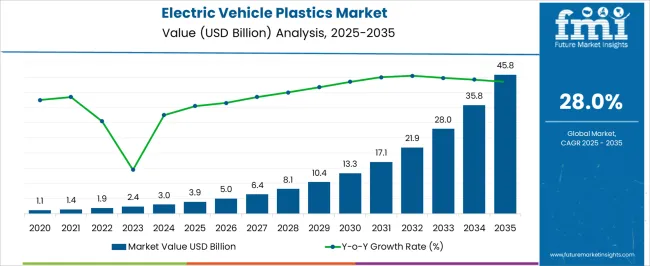
| Metric | Value |
|---|---|
| Electric Vehicle Plastics Market Estimated Value in (2025 E) | USD 3.9 billion |
| Electric Vehicle Plastics Market Forecast Value in (2035 F) | USD 45.8 billion |
| Forecast CAGR (2025 to 2035) | 28.0% |
The Electric Vehicle Plastics market is experiencing robust growth, driven by the rising adoption of electric vehicles worldwide and the increasing emphasis on lightweight, durable, and sustainable materials to enhance energy efficiency and vehicle performance. Plastics are being increasingly used to reduce vehicle weight, improve battery range, and meet design flexibility requirements in electric vehicles.
The market is further supported by advancements in polymer technologies, which provide improved mechanical strength, chemical resistance, and thermal stability, making them suitable for both structural and non-structural automotive components. Growing regulatory focus on emissions reduction and fuel efficiency is encouraging manufacturers to replace traditional metals with high-performance plastics.
Integration of electric vehicle production with circular economy practices, recycling initiatives, and material optimization strategies is also promoting adoption As the EV sector expands across passenger and commercial applications, the demand for diverse plastic materials and high-performance polymers is expected to sustain long-term growth, with ongoing innovations enabling lighter, safer, and more efficient vehicles.
The electric vehicle plastics market is segmented by electric vehicle type, plastic material, application, and geographic regions. By electric vehicle type, electric vehicle plastics market is divided into Battery Electric Vehicle (BEV), Hybrid Electric Vehicle (HEV), and Plug-In Hybrid Electric Vehicle (PHEV). In terms of plastic material, electric vehicle plastics market is classified into Polypropylene (PP), Polyethylene (PE), Acrylonitrile-Butadiene Styrene (ABS), Polyurethanes (PU), Polyamide (PA), Polycarbonate (PC), Polyvinyl Butyral (PVB), Polyvinyl Chloride (PVC), and Others. Based on application, electric vehicle plastics market is segmented into Exterior, Car Body, Lights, and Interior. Regionally, the electric vehicle plastics industry is classified into North America, Latin America, Western Europe, Eastern Europe, Balkan & Baltic Countries, Russia & Belarus, Central Asia, East Asia, South Asia & Pacific, and the Middle East & Africa.
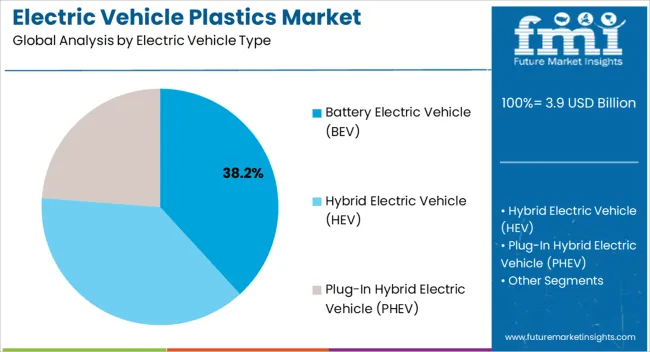
The battery electric vehicle (BEV) type segment is projected to hold 38.2% of the market revenue in 2025, establishing it as the leading electric vehicle type. Growth in this segment is driven by the global shift toward zero-emission mobility and the increasing production of BEVs by automotive manufacturers to meet regulatory mandates and consumer demand. The need for lightweight materials in BEVs is critical to maximize battery efficiency and extend driving range.
Plastics provide design flexibility for complex components while reducing overall vehicle mass, which enhances energy efficiency. In addition, the integration of plastics in structural and non-structural applications reduces manufacturing complexity and costs.
Advances in polymer engineering, coupled with the development of high-performance materials capable of withstanding thermal and mechanical stresses, have further strengthened the adoption of plastics in BEVs As global adoption of BEVs rises, this segment is expected to maintain its leadership, supported by the continued prioritization of lightweighting and performance optimization in electric vehicle design.
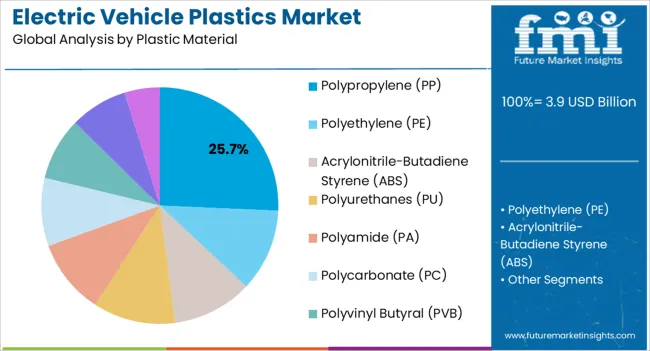
The polypropylene (PP) plastic material segment is anticipated to account for 25.7% of the market revenue in 2025, making it the leading plastic material category. PP is preferred for its lightweight, high chemical resistance, and versatility, which allows its application in both interior and exterior automotive components. The material’s durability and thermal stability make it suitable for the demanding operational conditions of electric vehicles, including exposure to varying temperatures and mechanical loads.
Manufacturers leverage polypropylene for cost-effective, high-volume production of automotive parts such as trims, panels, and battery housings. The recyclability and energy efficiency of PP further enhance its attractiveness in an era of sustainability-focused manufacturing.
Increasing demand for polymers that can combine performance, weight reduction, and design flexibility has reinforced polypropylene’s leading position As the electric vehicle market continues to grow, polypropylene is expected to remain a primary material choice, supported by ongoing research in enhancing polymer performance and adapting it to evolving automotive design requirements.
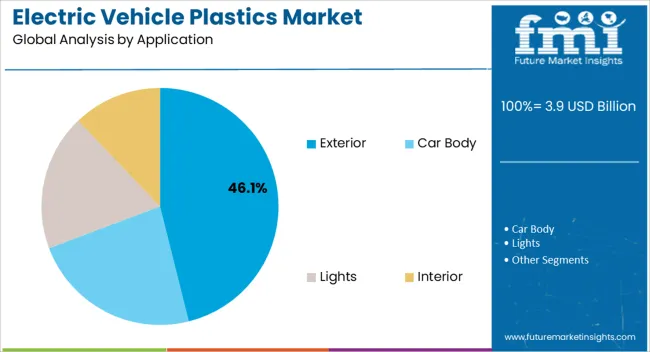
The exterior application segment is projected to hold 46.1% of the market revenue in 2025, making it the leading application area. Growth is driven by the requirement for lightweight, durable, and aesthetically versatile materials in vehicle exteriors, including bumpers, fenders, panels, and trims. Plastics reduce overall vehicle weight, improving energy efficiency and extending battery range, which is critical for electric vehicles.
They also offer design flexibility for aerodynamic optimization and customization without compromising structural integrity. Advanced polymer blends provide enhanced impact resistance, UV stability, and weather durability, ensuring long-term performance in exterior applications. Manufacturers increasingly adopt exterior plastics to meet both safety regulations and consumer preferences for modern vehicle designs.
Sustainability considerations, including recyclability and lower production energy requirements, further support adoption As electric vehicles continue to gain market share globally, the exterior application segment is expected to maintain its leadership, supported by innovations in polymer technology and lightweight automotive design strategies.
Increasing demand for electric vehicles owing to growing environmental awareness supported by innovation, government, and investments made by OEMs, has resulted in a technological revolution in the global automobile industry. Demand for electric vehicles thereby, lead to an increasing demand for allied industries such as plastics which is an essential material required in manufacturing of electric vehicles.
Manufacturers need lightweight materials to develop an electric vehicle which is one of the primary drivers for electric vehicle plastics market. Growing environmental concern is expected to increase the demand for electric vehicles which thereby would drive the demand for electric vehicle plastics market over the forecast period.
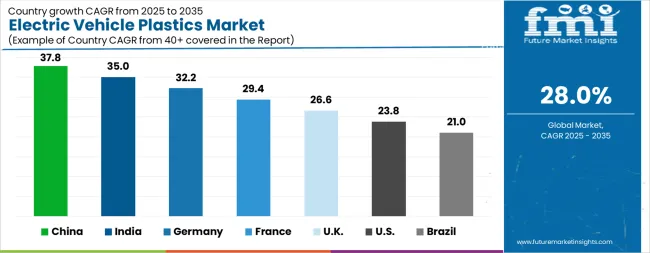
| Country | CAGR |
|---|---|
| China | 37.8% |
| India | 35.0% |
| Germany | 32.2% |
| France | 29.4% |
| UK | 26.6% |
| USA | 23.8% |
| Brazil | 21.0% |
The Electric Vehicle Plastics Market is expected to register a CAGR of 28.0% during the forecast period, exhibiting varied country level momentum. China leads with the highest CAGR of 37.8%, followed by India at 35.0%. Developed markets such as Germany, France, and the UK continue to expand steadily, while the USA is likely to grow at consistent rates. Brazil posts the lowest CAGR at 21.0%, yet still underscores a broadly positive trajectory for the global Electric Vehicle Plastics Market. In 2024, Germany held a dominant revenue in the Western Europe market and is expected to grow with a CAGR of 32.2%. The USA Electric Vehicle Plastics Market is estimated to be valued at USD 1.3 billion in 2025 and is anticipated to reach a valuation of USD 11.3 billion by 2035. Sales are projected to rise at a CAGR of 23.8% over the forecast period between 2025 and 2035. While Japan and South Korea markets are estimated to be valued at USD 190.9 million and USD 97.6 million respectively in 2025.
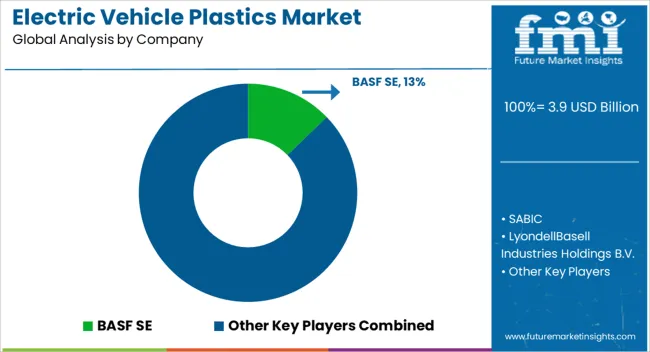
| Item | Value |
|---|---|
| Quantitative Units | USD 3.9 Billion |
| Electric Vehicle Type | Battery Electric Vehicle (BEV), Hybrid Electric Vehicle (HEV), and Plug-In Hybrid Electric Vehicle (PHEV) |
| Plastic Material | Polypropylene (PP), Polyethylene (PE), Acrylonitrile-Butadiene Styrene (ABS), Polyurethanes (PU), Polyamide (PA), Polycarbonate (PC), Polyvinyl Butyral (PVB), Polyvinyl Chloride (PVC), and Others |
| Application | Exterior, Car Body, Lights, and Interior |
| Regions Covered | North America, Europe, Asia-Pacific, Latin America, Middle East & Africa |
| Country Covered | United States, Canada, Germany, France, United Kingdom, China, Japan, India, Brazil, South Africa |
| Key Companies Profiled | BASF SE, SABIC, LyondellBasell Industries Holdings B.V., Evonik Industries, Covestro AG, Dupont, Sumitomo Chemicals Co. Ltd., LG Chem, Asahi Kasei, LANXESS, INEOS Group, Celanese Corp., AGC Chemicals, EMS-Chemie Holding, and Mitsubishi Engineering Plastics Corp. |
The global electric vehicle plastics market is estimated to be valued at USD 3.9 billion in 2025.
The market size for the electric vehicle plastics market is projected to reach USD 45.8 billion by 2035.
The electric vehicle plastics market is expected to grow at a 28.0% CAGR between 2025 and 2035.
The key product types in electric vehicle plastics market are battery electric vehicle (bev), hybrid electric vehicle (hev) and plug-in hybrid electric vehicle (phev).
In terms of plastic material, polypropylene (pp) segment to command 25.7% share in the electric vehicle plastics market in 2025.






Our Research Products

The "Full Research Suite" delivers actionable market intel, deep dives on markets or technologies, so clients act faster, cut risk, and unlock growth.

The Leaderboard benchmarks and ranks top vendors, classifying them as Established Leaders, Leading Challengers, or Disruptors & Challengers.

Locates where complements amplify value and substitutes erode it, forecasting net impact by horizon

We deliver granular, decision-grade intel: market sizing, 5-year forecasts, pricing, adoption, usage, revenue, and operational KPIs—plus competitor tracking, regulation, and value chains—across 60 countries broadly.

Spot the shifts before they hit your P&L. We track inflection points, adoption curves, pricing moves, and ecosystem plays to show where demand is heading, why it is changing, and what to do next across high-growth markets and disruptive tech

Real-time reads of user behavior. We track shifting priorities, perceptions of today’s and next-gen services, and provider experience, then pace how fast tech moves from trial to adoption, blending buyer, consumer, and channel inputs with social signals (#WhySwitch, #UX).

Partner with our analyst team to build a custom report designed around your business priorities. From analysing market trends to assessing competitors or crafting bespoke datasets, we tailor insights to your needs.
Supplier Intelligence
Discovery & Profiling
Capacity & Footprint
Performance & Risk
Compliance & Governance
Commercial Readiness
Who Supplies Whom
Scorecards & Shortlists
Playbooks & Docs
Category Intelligence
Definition & Scope
Demand & Use Cases
Cost Drivers
Market Structure
Supply Chain Map
Trade & Policy
Operating Norms
Deliverables
Buyer Intelligence
Account Basics
Spend & Scope
Procurement Model
Vendor Requirements
Terms & Policies
Entry Strategy
Pain Points & Triggers
Outputs
Pricing Analysis
Benchmarks
Trends
Should-Cost
Indexation
Landed Cost
Commercial Terms
Deliverables
Brand Analysis
Positioning & Value Prop
Share & Presence
Customer Evidence
Go-to-Market
Digital & Reputation
Compliance & Trust
KPIs & Gaps
Outputs
Full Research Suite comprises of:
Market outlook & trends analysis
Interviews & case studies
Strategic recommendations
Vendor profiles & capabilities analysis
5-year forecasts
8 regions and 60+ country-level data splits
Market segment data splits
12 months of continuous data updates
DELIVERED AS:
PDF EXCEL ONLINE
Electric Vehicle Sensor Market Forecast and Outlook 2025 to 2035
Electric Vehicle Motor Market Forecast and Outlook 2025 to 2035
Electric Vehicle Battery Conditioners Market Size and Share Forecast Outlook 2025 to 2035
Electric Vehicle Transmission Market Size and Share Forecast Outlook 2025 to 2035
Electric Vehicle Fluid Market Size and Share Forecast Outlook 2025 to 2035
Electric Vehicle E-Axle Market Size and Share Forecast Outlook 2025 to 2035
Electric Vehicle On-Board Charger Market Size and Share Forecast Outlook 2025 to 2035
Electric Vehicle Finance Market Size and Share Forecast Outlook 2025 to 2035
Electric Vehicle Contactor Market Size and Share Forecast Outlook 2025 to 2035
Electric Vehicle Communication Controller Market Size and Share Forecast Outlook 2025 to 2035
Electric Vehicle Charging Cable and Plug Market Size and Share Forecast Outlook 2025 to 2035
Electric Vehicle Battery Formation and Testing Market Size and Share Forecast Outlook 2025 to 2035
Electric Vehicle Range Extender Market Size and Share Forecast Outlook 2025 to 2035
Electric Vehicle Charging Station Market Size and Share Forecast Outlook 2025 to 2035
Electric Vehicle Relays Market Size and Share Forecast Outlook 2025 to 2035
Electric Vehicle DC Contactor Market Size and Share Forecast Outlook 2025 to 2035
Electric Vehicle Test Equipment Market Size and Share Forecast Outlook 2025 to 2035
Electric Vehicle Battery Connector Market Size and Share Forecast Outlook 2025 to 2035
Electric Vehicle Reducer Market Growth - Trends & Forecast 2025 to 2035
Electric Vehicle Insulation Market - Growth & Demand 2025 to 2035

Thank you!
You will receive an email from our Business Development Manager. Please be sure to check your SPAM/JUNK folder too.
Chat With
MaRIA